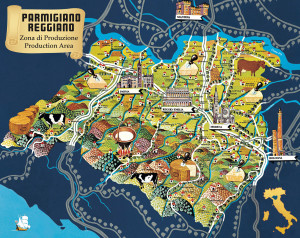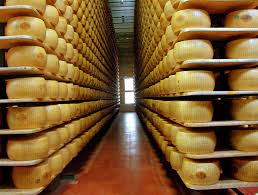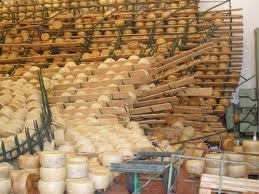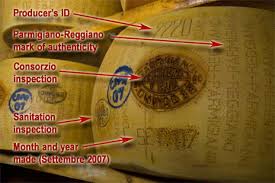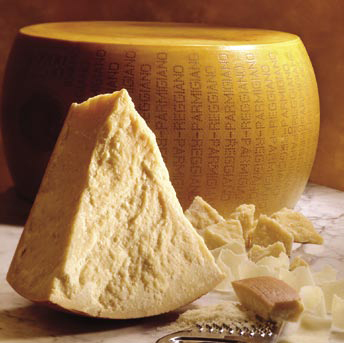
Like pizza, pasta, espresso coffee, and gelato parmigiano reggiano, produced in the approved areas of the provinces of Parma, Reggio Emilia, Modena, Bologna, and Mantua is a quintessential Italian food product. Recent statistics recount that c. 240,000 cows, mostly Friesian, produce the raw milk used to make parmigiano reggiano wheels at some 3,558 milk–producing farms. The milk then goes to 382 multi-member consortiums to be made into cheese. More than 8 quarts of milk are needed to make one pound of parmigiano. On average each producer makes 23 wheels of parmigiano per day. The average weight of a wheel is 86 pounds. Last year a total of 3,231,862 wheels were produced.
Parmigiano, nicknamed “The King of Cheeses,” holds many records: it contains no additives, no preservatives, and almost 0% fats. It is made entirely by hand. Sadly, it is the most counterfeited cheese on earth. Everyone— Russia, Eastern Europe, Brazil, Argentina, Australia, and China, but with first prize going to the US–tries to make it with very poor results, but at great profit. Wisconsin, New York, and California are the worst American culprits but The Amish produce a vegan one and supermarket chains promote a kit to make-your-own, authentic after two months of aging. Last year the number of counterfeit wheels worldwide was greater than the authentic ones for the first time. Yet sadly the Italian Government pontificates, but takes little action to protect its unique artisanal products be they high fashion or food.
Speaking of artisanal products, each wheel of parmigiano differs slightly from another in small ways. According to www.parmesan.com: “each batch of milk is slightly different, depending on the particular cow, and what she ate, the season of the year, the precise geographic location of the herd, the soil, the climate…The practices of cheese artisans may differ in subtle ways—and the length of aging of each wheel can certainly vary.” Nonetheless, because parmigiano is always made according to the same regulations and the same traditional methods, the consumer can always count on the highest quality.
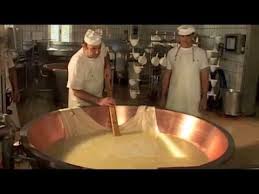
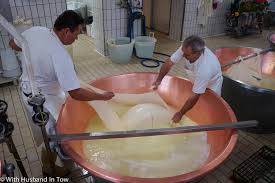

Thus the present situation is ever the more tragic. The highest quality of Parmigiano Reggiano D.O.P. (standing for denominazione d’origine protetta or roughly “protected designation of origin”) still produced today in the Apennines of Emilia-Romagna exactly as it was by Benedictine monks in the 12th century, is at risk. Yes, at the risk of disappearing from the face of the earth along with a centuries-long way of life!
This is not a threat or an exaggeration; it’s reality. Production costs have become prohibitive for its many small producers in the mountains. It’s this system that’s brought them to their knees. Although the alarm has been ringing for some time now, in the past twelve months dozens of small producers have closed; others are on the brink. The economic situation is better for the parmigiano reggiano producers at sea level in spite of their devastating losses after the earthquake in 2112. Here each producer can count on more space and thus more cows and each consortium has more members. Since they are more in number and bigger, they have also have a larger margin of earnings.
In spite of meetings in the Italian Senate, visits to the area by Maurizio Martina, Italy’s Minister of Agriculture since February 2014, who promised a project to relaunch this Italian unicum, nothing has happened. A cloud of hot air! Actually the Italians say: Tutto fumo, niente arrosto! (“All smoke, no roast!).
Luckily to save these mountain producers’ way of life, the bishop of Reggio Emilia Massimo Camisasaca as well as Leana Pignedoli, a member of the Democratic Party (PD) and the Vice President of the Senate’s Agricultural Commission have both rushed to the rescue. “If Parmigiano production collapses, which is the only agricultural resource of this mountainous area,” Bishop Camisasaca said, “this age-old rural way of life, this tradition will disappear; the damage will cause a chain reaction.” Their aim is to compile an official list of producers and protect them from price speculation. It’s a case of “too many cooks spoil the broth” or in this case, the Bishop likes to say “toomany hands milking the poor cow which only receives a few drops of milk in return.” In short, the cheesemaker receives only c. $17.00 euro for every pound of parmigiano produced which is sold to the consumer at between c. $43 and c. $58 per pound because of too many middlemen.
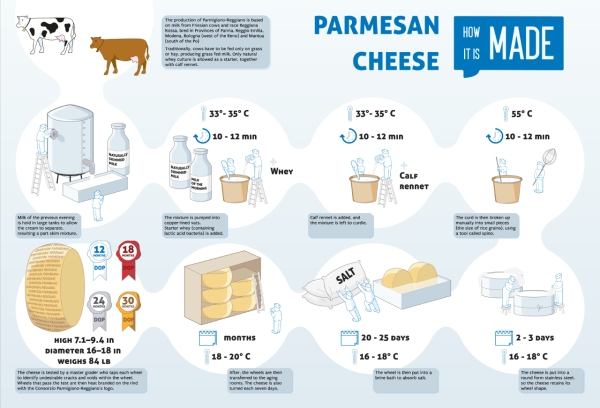
A second problem, a serious one, is the “system” I mentioned above. The cheesemaker has to pay for the milk upfront. To make a wheel of parmigiano which weighs over 80 pounds, he needs to buy some 530 quarts of milk, but then has to wait one to two years for the cheese to age. In fact, the minimum aging time for a wheel to be eaten in Italy is 12 months, for Export 18 months, and the average aging time is 20-24 months. The older the cheese, the higher the price.
A third problem is that during the past few years thousands of wheels have not been sold because of the worldwide economic crisis. To alleviate this problem the President of the Consortium of Cheesemakers, Giuseppe Alai, probably in good faith suggested producing less because only 30% of production is exported and 80% of that only to 4 countries, one of which is the USA. The irony of this decision is that while dozens of cheesemakers’ businesses close, the request from abroad for parmigiano keeps increasing. Exports to the US alone increased by 40% in 2014. Thus, instead of decreasing production the Consortium would have needed to potentiate its marketing and export campaigns abroad.
Yet in spite of Milan’s long awaited and heavily publicized Expo 2015 dedicated to feeding the planet, milk tankers and freight trucks filled with powdered milk and counterfeit “Italian” cheese, produced at a low cost, continue to enter Italy undisturbed from Northern and Eastern Europe through the Brenner Pass.
As if that isn’t bad enough, on July 1st, according to www.slowfood.com, “The European Commission has sent an official letter to Italy asking for it to abolish the 1974 national law banning the use of ‘milk powder, condensed milk, and reconstituted milk’ in the manufacture of dairy products. According to Brussels, Italy must conform to the European regulations that allow these ingredients, and the current Italian law prohibiting these milk surrogates represents a ‘restriction on the free movement of goods’.”
“Instead, in Slow Food’s opinion, this imposition is not only wrong and detrimental to the protection of biodiversity, but Italy should in fact become an example for quality European cheesemaking. We need to work towards greater awareness at a European level, with the aim of bringing the laws of other countries in line with Italian legislation.”
“We hope that the Italian government will defend the 1974 law,” said Piero Sardo, the President of the Slow Food Foundation for Biodiversity. “After chocolate with no cocoa butter and wine without grapes, big business is now trying to attack another key sector of the Italian food industry, with a race to the bottom. If this new demand is accepted, Italy’s quality dairy sector, already crushed by too-low milk prices and the challenges facing those who farm in the mountains, will suffer severe consequences. Slow Food has been fighting for years to promote raw milk cheeses, mountain cheesemaking, traditional techniques, and native breeds. Our commitment dates back to the first edition of Cheese in 1997, when we began gathering signatures on a petition in favor of raw milk, which was then delivered to the European institutions. The best producers from around Europe will be in Bra for Cheese 2015 from September 18-21 to join us in the fight against this latest absurdity and to work towards the Italian example being extended to the rest of Europe.”
Although it’s the most recent disaster, parmigiano, though the most famous, is not the only cheese the Italian Government is not sufficiently protecting. The present situation hurts all the some 2,000 Italian producers of some 400 different cheeses, 60% of whom are small-producers, and their consumers, who think they’re eating a healthy, artisanal product, when they’re not.
This is due to yet another scandal, one that Slow Food has been denouncing for years: the ridiculous legal label requirements for cheese. Powdered milk, therefore, would enter into Italian cheeses without any indication on the label, as is already the case in the rest of Europe. Instead Slow Food insists that “the consumer should be protected with clear and legible labels, with products of quality, with transparency and honesty; not suffer from the pursuit of low prices and higher profits.”
For indeed replacing or adding powdered milk instead of raw milk to cheese is a question of higher profits. Slowfood reports: “Because one kilo (2.2 pounds) of powdered milk costs around two euros (c. $2.20), and with this amount it’s possible to produce 10 liters of liquid milk, while if it (raw milk) were bought from a farmer it would cost 3.60 euros (c. $4.00). Moreover, loading sacks of powdered milk onto a truck and then storing it (sometimes for up to a month) is vastly more convenient and cheaper than relying on traveling tankers, the use of fridges, pasteurization, and the use of tanks for liquid milk. It’s all here plain to see: $1.80 per liter saved on milk, lower logistic costs and greater convenience.”
Only 40 cheeses (including parmigiano reggiano of course) out of Italy’s some 400 have D.O.P. and I.G.P. status. They are worth about 40% of the total Italian cheesemaking market (1,300,000 tons), but if even they aren’t at risk, the other 60% is almost certainly doomed.
Perhaps this indifference and confusion help to explain why Coca Cola and McDonalds are the main sponsors of Expo. Barilla, De Cecco, Lavazza, Illy, Nespresso, Galbani, Zonin, Eataly, to name but a few of Italy’s major food and wine industries and retailers, where were (are) you? It’s time you united to protect and promote Italy’s, but also your, most important and unique industries: cultural, artisanal, and enogastromic!
![]()

